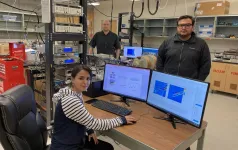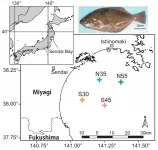(Press-News.org) More sleep could offset children's excess indulgence over the school holidays as new research from the University of South Australia shows that the same decline in body mass index may be achieved by either extra sleep or extra exercise.
The striking new finding is part of a study that shows how children can achieve equivalent physical and mental health benefits by choosing different activity trade-offs across the 24-hour day.
Conducted in partnership with the Murdoch Children's Research Institute, and supported by the National Heart Foundation of Australia, the team examined the optimal balance between children's physical activity, sleep, and sedentary time across the 24-hour day to better inform tailored lifestyle choices.
On a minute-for-minute basis, moderate-to-vigorous physical exercise was shown to be 2-6 times more potent than sleep or sedentary time.
While exercise has a greater and faster impact on physical health and wellbeing, children may be able to achieve the same 7.4% reduction in body mass index (BMI) by either:
exercising 17 more minutes (moderate-to-vigorous exercise) OR
sleeping an extra 52 minutes OR
reducing their sitting or sedentary time by an extra 56 minutes.
Similarly, children may significantly improve their mental health by either:
exercising 35 minutes more (moderate-to-vigorous exercise), OR
sleeping an extra 68 minutes OR
reducing their sitting or sedentary time by 54 minutes.
The study assessed 1179 children aged 11-12 years, from the cross-sectional Child Health CheckPoint Study. Physical wellbeing was measured via BMI, waist girth and body fat; mental wellbeing was measured via self-reported responses on the Paediatric Quality of Life Inventory.
Lead researcher, UniSA's Dr Dot Dumuid, says that the findings provide options for busy families looking to get the most value out of their day.
"There are many competing time demands in modern families ¬- whether it's after school soccer, music lessons, or simply walking the family dog, finding the time to fit everything into a single day, can be a challenge," Dr Dumuid says.
"International guidelines suggest that children need 9-11 hours' sleep, 60 minutes of physical exercise, and no more than two hours of recreational screen time per day, yet only seven percent of children are regularly meeting these goals.
"With so many competing priorities and commitments, it's helpful to know which activities deliver the greatest 'bang for your buck'.
"In this research we calculated how much sleep, sedentary time, light exercise, and moderate-to-vigorous exercise was associated with the same improvements in mental health, physical health and academic achievement.
"For families with very little available time, small increases in moderate-to-vigorous exercise could be an option to improve children's health and wellbeing; alternatively an earlier night could equally deliver the same health benefits - importantly, it's the flexibility that these findings offer that make them so valuable.
"Exploring trade-offs between children's activities is a promising way for families to make healthy choices that suit their regular family schedule."
The Heart Foundation's Director of Physical Activity, Adjunct Professor Trevor Shilton, said the Heart Foundation was happy to support such an innovative approach to investigating children's physical health and mental wellbeing.
"This study confirms that physical activity is the quickest and most effective way to deliver benefits for children's physical health and mental wellbeing. But the findings also offer some flexibility for families," Professor Shilton says.
"Helping young people make healthy choices and helping families create an environment that supports them in these choices can improve their quality of life in the future, as well as reducing their risk of chronic diseases, such as heart disease."
INFORMATION:
Media contact: Annabel Mansfield T: +61 8 8302 0351 M: +61 417 717 504
E: Annabel.Mansfield@unisa.edu.au
Researchers for media comment:
University of South Australia - Dr Dot Dumuid E: Dot.Dumuid@unisa.edu.au
University of South Australia - Professor Tim Olds E: Timothy.Olds@unisa.edu.au
Murdoch Children's Research Institute - Professor Melissa Wake E: melissa.wake@mcri.edu.au
Heart Foundation - Adjunct Professor Trevor Shilton E: Trevor.Shilton@heartfoundation.org.au
RIVERSIDE, Calif. -- Researchers at the University of California, Riverside, have used a nanoscale synthetic antiferromagnet to control the interaction between magnons -- research that could lead to faster and more energy-efficient computers.
In ferromagnets, electron spins point in the same direction. To make future computer technologies faster and more energy-efficient, spintronics research employs spin dynamics -- fluctuations of the electron spins -- to process information. Magnons, the quantum-mechanical units of spin fluctuations, interact with each other, leading to nonlinear features of the spin dynamics. Such nonlinearities play a central ...
Collagen is a protein found widely in almost all cells of animals, and scientifically can be used to learn much about an animal's life history including human being in the present or in the past. Scientists at the Research Institute for Humanity and Nature (RIHN) and Japan Fisheries Research and Education Agency (FRA), Japan, prove this point for Japanese flounder by measuring isotope ratios in vertebral-bone collagen. The new study, which can be read in Marine Biology, shows that there exist behavioral groups of fish with different migrating and/or feeding patterns.
A school of fish will decide their habitat on fundamental needs for survival, ...
Researchers at the National Food Institute have come up with a solution that can help combat both food loss and food waste: They have generated a natural lactic acid bacterium, which secretes the antimicrobial peptide nisin, when grown on dairy waste.
Nisin is a food-grade preservative, which can extend the shelf life of foods, and thus can be used to reduce food waste. The discovery also makes it possible to better utilize the large quantities of whey generated when cheese is made.
Nisin is approved for use in a number of foods, where it can prevent the growth of certain spoilage microorganisms as well as microorganisms that make consumers sick. It can for instance inhibit spore ...
The target of carbon-neutral and net-zero emissions is the development and utilization of renewable energy. High-energy-density energy storage systems are critical technologies for the integration of renewable energy.
Li metal is highly recognized as a promising alternative anode for next-generation rechargeable batteries due to its high theoretical capacity of 3860 mAh g-1 and ultralow electrode potential of -3.04 V compared to the standard hydrogen electrode.
However, Li metal batteries' (LMBs) main issue is their low Coulombic efficiency (CE), which limits batteries' cycle life. The low CE in LMBs occurs ...
Age may adversely affect women's fertility by impairing levels of RNA molecules which in turn alter the function of genes involved in key biological pathways during the final maturation stage of a human egg cell, according to the findings of a new study published today in the journal Aging Cell.
Researchers from the Centre for Genomic Regulation (CRG), the Centro Nacional de Análisis Genómico (CNAG-CRG) and Clínica Eugin sequenced the RNA molecules, also known as the transcriptome, within oocytes to understand which genes are affected in their activity by age. They used single-cell sequencing to analyse the transcriptome of 72 individual oocytes ...
BUFFALO, N.Y. -- A national, University at Buffalo-led study on genes in pediatric cardiomyopathy demonstrates strong evidence for routine genetic screening in children with the disease. The study, published April 28 in the Journal of the American Heart Association, revealed wide variation in screening, with some centers conducting routine genetic testing and others conducting none.
Conducted at 14 centers, the National Institutes of Health-funded study of 152 children with cardiomyopathy found that only half had undergone genetic screening. Of those who hadn't undergone screening, 21% were found to have a genetic cause for the ...
Under normal, healthy circulatory conditions, the von Willebrand Factor (vWF) keeps to itself. The large and mysterious glycoprotein moves through the blood, balled up tightly, its reaction sites unexposed. But when significant bleeding occurs, it springs into action, initiating the clotting process.
When it works properly, vWF helps stop bleeding and saves lives. However, according to the Centers for Disease Control and Prevention (CDC), about 60,000 to 100,000 Americans die each year from thrombosis, a disorder characterized by too much clotting. Blood clots can trigger a stroke or heart attack.
According ...
Today at the Microbiology Society's Annual Conference, Yang Liu, researcher at Hong Kong Polytechnic University, will discuss a new technique to trap and recover microplastics.
The method uses bacterial biofilms, a sticky substance created by micro-organisms, to trap microplastic particles. The biofilm is then processed and dispersed, releasing the microplastic particles for processing and recycling.
Liu and colleagues used the bacterium Pseudomonas aeruginosa to capture microplastics in a bioreactor. This species of bacteria is found in all environments and has previously been shown to colonise microplastics in the environment.
P. aeruginosa biofilms ...
Research shows that children who experience puberty earlier than their peers are more likely to begin drinking alcohol at a young age and early alcohol exposure is also known to be related to alcohol dependence later in life. Specifically, adolescents who mature early are two to three times more likely to drink than other youth. In addition, early maturing girls are two to three times more likely to drink until intoxication and three times as likely to have an alcohol use disorder. A new study examined why early developing 14-year-old adolescents are more likely to drink alcohol compared to those whose pubertal development is on-time or late. The findings show these adolescents are more likely to have ...
Frequent use of exemptions may undermine public health protections of oil and gas setback policies, according to a new study led by researchers at the research institute PSE Healthy Energy, Harvard University, and Nicholas Institute for Environmental Solutions at Duke University. The study, published April 28, 2021 in Energy Policy, is the first to assess the effectiveness of distance-based setback regulations for unconventional natural gas development (UNGD) or "fracking."
"Setback regulations are commonly employed to protect public health, so we wanted to test if they're effective in practice," said lead author Drew Michanowicz, DrPH, ...




